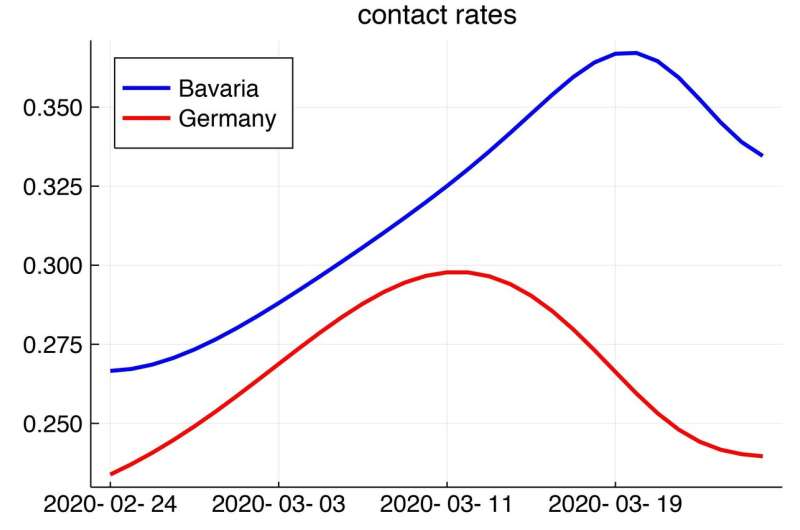Reliable coronavirus analyses through data assimilation: Expert presents novel calculations

Thanks to methods used in fluid mechanics, the course of a pandemic and the effectiveness of government containment measures can be assessed promptly and accurately, and forecasts can be derived. This approach is being pursued by Prof. Dr. Jörn Sesterhenn, Chair of Technical Mechanics & Fluid Mechanics at the University of Bayreuth. His case studies apply data assimilation—a proven method in fluid mechanics and weather forecasting—to the development of the corona pandemic in heavily affected countries.
Case studies on Germany and Bavaria, for example, clearly show the increase in contact rates following the public holidays in February, and their weakening as a result of government measures. These and numerous other case studies, which are already available online, are based on a classical model of the spread of epidemics. For the development of more detailed models, the Bayreuth scientist considers close cooperation with experts in epidemiology to be urgently necessary.
The case studies now published show the number of people currently infected and those who have recovered. These figures would otherwise be unknown. Above all, the case studies provide information about contact rates, i.e. how many people an infected person infects on average. "The contact rate is the only parameter that health policy-makers have at their disposal to contain the pandemic, as long as there is no vaccine and no quick cure, and data assimilation can be used to indicate this with much greater certainty than would normally be the case. Moreover, just a few days after a health policy measure has been taken, it is possible to see with hindsight how the contact rate has developed in this short period of time. This development cannot be clearly seen in the case numbers themselves after such a short time," Sesterhenn explains."
"This approach is very promising in my view. The more accurate our forecasts on the development of the coronavirus pandemic are, the more targeted we can be in taking action. Our top priority is health. But of course, every decision we take must always take into account the impact on our everyday lives. This model might provide further orientation," said Science Minister Bernd Sibler. He added: "With this, the University of Bayreuth shows once again how important it is in science to conduct research across subject boundaries."
Data assimilation applied to the coronavirus epidemic
Every evaluation of complex, empirically verified data is based on a model. Data assimilation is a method established in the natural sciences, engineering and social sciences, which aims to optimize the respective model for the data measured. This makes it possible to obtain further reliable data from the model, beyond the given data with regard to the present and future. Prof. Dr. Jörn Sesterhenn is chair of Technical Mechanics & Fluid Mechanics at the University of Bayreuth. In view of the worrying spread of the coronavirus pandemic and the increasing need for valid forecasts, he had the idea of transferring this proven research method to coronavirus. He bases his calculations on two sources: the empirical data published daily by Johns Hopkins University and the Robert Koch Institute, and a model that follows a classical approach developed in epidemiology. This is a so-called SIR model (Susceptible Infected Removed Model).
The statistics of Johns Hopkins University and the Robert Koch Institute contain the published information about the number of people who have tested positive for coronavirus, and how many of these people have died in the meantime. "The data assimilation procedure now offers us the opportunity to obtain further important information from these empirical data sets—for example, how many people in the respective countries are currently infected with the virus, and how many people will become infected in the future if certain social or health policy conditions remain the same or change.
The effect of certain health policy measures can then be estimated relatively accurately in retrospect. Valid prognoses are also possible with regard to the question of how high the proportion of people who survive a proven infection is. This in turn enables us to derive recommendations for action in governmental health policy as well as for individuals," Sesterhenn explains. At the same time, the scientist from Bayreuth emphasizes that the more precise the underlying model, the more reliable the data thus obtained will be.
Urgently needed: an interdisciplinary optimization of models
"In fluid mechanics today, reliable predictions can be made using data assimilation and realistic models. For example, thanks to a detailed reconstruction of the oil spill that occurred in the Gulf of Mexico in 2010, the course of an oil spill in the sea can be predicted with a high degree of accuracy. With regard to analyses and prognoses of the coronavirus epidemic, interdisciplinary cooperation between experts is now urgently needed. The Royal Society in Great Britain has now called for this, and I am happy to be making my contribution. I would also like to see a top-class team of experts in Bavaria. All the sooner will we be able to develop the best possible, well-founded analyses, and make recommendations for dealing with coronavirus," Sesterhenn urges.
More information: Adjoint-based Data Assimilation of an Epidemiology Model for the Covid-19 Pandemic in 2020. Zenodo (2020), Preprint. doi: dx.doi.org/10.5281/zenodo.3733244


















